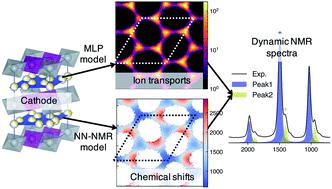当前位置:
X-MOL 学术
›
Chem. Sci.
›
论文详情
Our official English website, www.x-mol.net, welcomes your feedback! (Note: you will need to create a separate account there.)
A machine learning protocol for revealing ion transport mechanisms from dynamic NMR shifts in paramagnetic battery materials
Chemical Science ( IF 8.4 ) Pub Date : 2022-06-13 , DOI: 10.1039/d2sc01306a Min Lin 1 , Jingfang Xiong 1 , Mintao Su 1 , Feng Wang 1 , Xiangsi Liu 1 , Yifan Hou 1 , Riqiang Fu 2 , Yong Yang 1, 3 , Jun Cheng 1, 4
Chemical Science ( IF 8.4 ) Pub Date : 2022-06-13 , DOI: 10.1039/d2sc01306a Min Lin 1 , Jingfang Xiong 1 , Mintao Su 1 , Feng Wang 1 , Xiangsi Liu 1 , Yifan Hou 1 , Riqiang Fu 2 , Yong Yang 1, 3 , Jun Cheng 1, 4
Affiliation

|
Solid-state nuclear magnetic resonance (ssNMR) provides local environments and dynamic fingerprints of alkali ions in paramagnetic battery materials. Linking the local ionic environments and NMR signals requires expensive first-principles computational tools that have been developed for over a decade. Nevertheless, the assignment of the dynamic NMR spectra of high-rate battery materials is still challenging because the local structures and dynamic information of alkali ions are highly correlated and difficult to acquire. Herein, we develop a novel machine learning (ML) protocol that could not only quickly sample atomic configurations but also predict chemical shifts efficiently, which enables us to calculate dynamic NMR shifts with the accuracy of density functional theory (DFT). Using structurally well-defined P2-type Na2/3(Mg1/3Mn2/3)O2 as an example, we validate the ML protocol and show the significance of dynamic effects on chemical shifts. Moreover, with the protocol, it is demonstrated that the two experimental 23Na shifts (1406 and 1493 ppm) of P2-type Na2/3(Ni1/3Mn2/3)O2 originate from two stacking sequences of transition metal (TM) layers for the first time, which correspond to space groups P63/mcm and P6322, respectively. This ML protocol could help to correlate dynamic ssNMR spectra with the local structures and fast transport of alkali ions and is expected to be applicable to a wide range of fast dynamic systems.
中文翻译:

一种机器学习协议,用于从顺磁性电池材料的动态 NMR 变化中揭示离子传输机制
固态核磁共振 (ssNMR) 提供了顺磁性电池材料中碱金属离子的局部环境和动态指纹。将局部离子环境和 NMR 信号联系起来需要昂贵的第一性原理计算工具,这些工具已经开发了十多年。然而,高倍率电池材料的动态核磁共振谱的分配仍然具有挑战性,因为碱离子的局部结构和动态信息高度相关且难以获取。在这里,我们开发了一种新的机器学习 (ML) 协议,该协议不仅可以快速采样原子配置,还可以有效地预测化学位移,这使我们能够以密度泛函理论 (DFT) 的准确性计算动态 NMR 位移。使用结构明确的 P2 型 Na以2/3 (Mg 1/3 Mn 2/3 )O 2为例,我们验证了 ML 协议并展示了动态效应对化学位移的重要性。此外,通过该协议,证明了P2 型 Na 2/3 (Ni 1/3 Mn 2/3 )O 2的两个实验性23 Na 位移(1406 和 1493 ppm)源自过渡金属的两个堆叠序列(TM) 层,对应于空间群P 6 3 / mcm和P 6 322,分别。该 ML 协议有助于将动态 ssNMR 光谱与局部结构和碱离子的快速传输相关联,并有望适用于广泛的快速动态系统。
更新日期:2022-06-13
中文翻译:

一种机器学习协议,用于从顺磁性电池材料的动态 NMR 变化中揭示离子传输机制
固态核磁共振 (ssNMR) 提供了顺磁性电池材料中碱金属离子的局部环境和动态指纹。将局部离子环境和 NMR 信号联系起来需要昂贵的第一性原理计算工具,这些工具已经开发了十多年。然而,高倍率电池材料的动态核磁共振谱的分配仍然具有挑战性,因为碱离子的局部结构和动态信息高度相关且难以获取。在这里,我们开发了一种新的机器学习 (ML) 协议,该协议不仅可以快速采样原子配置,还可以有效地预测化学位移,这使我们能够以密度泛函理论 (DFT) 的准确性计算动态 NMR 位移。使用结构明确的 P2 型 Na以2/3 (Mg 1/3 Mn 2/3 )O 2为例,我们验证了 ML 协议并展示了动态效应对化学位移的重要性。此外,通过该协议,证明了P2 型 Na 2/3 (Ni 1/3 Mn 2/3 )O 2的两个实验性23 Na 位移(1406 和 1493 ppm)源自过渡金属的两个堆叠序列(TM) 层,对应于空间群P 6 3 / mcm和P 6 322,分别。该 ML 协议有助于将动态 ssNMR 光谱与局部结构和碱离子的快速传输相关联,并有望适用于广泛的快速动态系统。

























 京公网安备 11010802027423号
京公网安备 11010802027423号